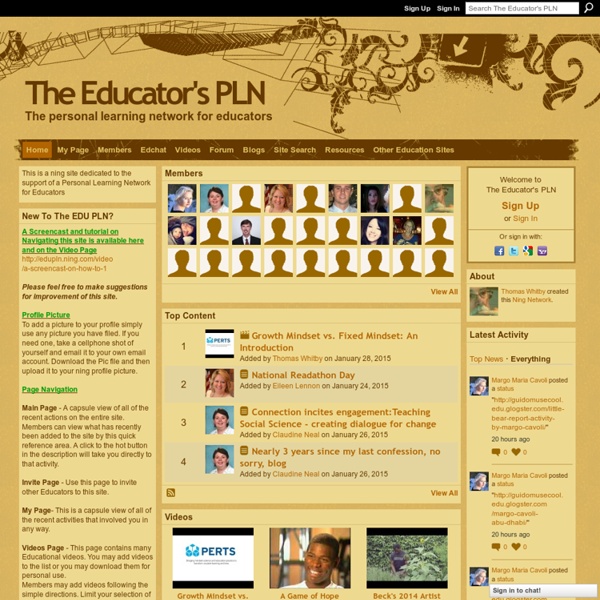



New Tool Makes PD Planning Simple Salt Lake City, UT (PRWEB) December 19, 2011 PD developer School Improvement Network has added yet another tool to its premiere professional development platform, PD 360. The new addition, called My Portfolio, is a groundbreaking function within the PD 360 platform that gives educators the opportunity to create, share, and implement personalized professional learning plans. With My Portfolio, teachers and administrators alike have the ability to create professional learning plans and share them with anyone in their network across departments, schools, and the entire district. My Portfolio’s reporting function makes follow-up and accountability simple and easy, giving educators the power to turn goals into accomplishments. With My Portfolio, teachers and instructional leaders can: Create their own professional learning plans Showcase the professional learning elements that have been completed Easily generate reports of plans and what has been completed
Transforming failing Public Schools: closing the achievement gap Los argentinos, quintos en el uso de redes sociales Los argentinos están entre los usuarios de Internet más adeptos a las redes sociales. Una investigación sobre hábitos online que abarcó países de América, Europa, Africa, Asia y Oceanía, ubicó a los argentinos en el quinto puesto entre los que más utilizan esas redes. Preguntados sobre la utilización de redes sociales, un 62% de los argentinos con acceso a Internet afirmó usar alguna. En la lista general, por encima de los argentinos sólo quedaron los internautas de Turquía, con un 73%, seguidos por los de Malasia (69%), los tailandeses (67 %) y los de Hong Kong (63 %). La investigación fue llevada a cabo por la consultora TNS, e implicó unas 50.000 entrevistas a usuarios de Internet de 46 países. En el caso de la Argentina, esta investigación le pone números a un fenómeno comunicativo muy notable en los últimos meses. Para Constanza Cilley, gerente general de TNS Argentina, “la alta participación en redes sociales es una clara prueba de que la Web 2.0 vino para quedarse”.
Engaging Thinking | Mind Mapping with Mindomo Mind Mapping is a fantastic tool that helps students (and teachers) to visualise thinking in an organised way. Personally, mind maps have helped me to learn a vast amount amount of information without needing to read through pages of endless notes. Tony Buzan’s Mind Map strategy has helped educators around the world to break down the concept into simple rules to help students understand how they can organise their ideas in an effective way. Mindomo is an online application where users can create, view and share mind maps in their browser. What I really like about Mindomo is that it creates mind maps according to the Buzan structure: A central image with branches and sub branchesAll writing presented on horizontal branchesEach branch and corresponding writing are colour codedImages linked to keywords The program gives you the flexibility to change the visual features, layout, font, colour and theme of the map. ‘New Horizons’ in engaging technologies Key Trends 1.
Overwhelmed? Welcome the Age of Curation | Epicenter Forrester Research analyst Sarah Rotman Epps coined a phrase Friday for something many have been talking about since Apple launched the iPad about six weeks ago. “Curated computing” refers to the way Apple staff examines each piece of software written for iPhone OS devices before allowing it into (or blocking it from) the App Store. Epps is almost certainly not among the first 10,000 people on the planet to observe that the iPhone OS does not allow users to install whatever programs they wish, unless the devices are jailbroken. For that reason, it’s tempting to write off her coinage as an attention-grabbing rehash of a well-worn meme — especially because she plans to take this show on the road at conferences to talk about this observation. However, Epps is onto something with this word, curated. Curation is the positive flip side of Apple’s locked-down approach, decried as a major, negative development in computing by many observers, present company included. For example: See Also:
Argentina, el país con más usuarios de Redes Sociales de América Información General Argentina, el país con más usuarios de Redes Sociales de América 09/01/11 |En tan sólo un par de años, Argentina llegó a ocupar el quinto lugar a nivel mundial de usuarios registrados en las denominadas Redes Sociales como: Facebook, Twitter, Linkedin, Flickr, entre otros. A su vez, en América, los usuarios argentinos superan en número incluso a Estados Unidos. El mensaje enviado por el Usuario del Servicio y su contenido es de única y exclusiva responsabilidad civil y penal de quien lo envió y/o utilizó. Este diario no garantiza la veracidad de los datos personales y/o contenidos de cada mensaje efectuados y/o publicados en los Servicios por el Usuario. NO está permitido: 1. utilizar lenguaje vulgar /obsceno, discriminatorio y/u ofensivo o Está prohibido todo tipo de ataque personal contra Usuarios de los Servicios y/u otros terceros, mediante acoso, amenazas, insultos. 2.
The Economics of Seinfeld Why Content Curation is the new Blogging « (clicca qui per la traduzione in italiano) During these days I’m questioning myself about today’s online media industry recurring topic of discussion: the so-called content curation. The term itself can be identified with the concept of “caring about content.” This concept, obviously, can be investigated from a variety of viewpoints: it revolves around manipulating information, news, contents available online to a new form with sensibly higher ambitions in terms of vision, lifecycle and usefulness. It’s about producing contents that, on average, are well worth an enhanced amount of attention respect to the so-called “world buzz,” the avalanche of information micro-bits, we receive daily from the Internet through social media, blogs, online newspapers, and sometimes and unfortunately from content farms. On a more operational level, an interesting definition that you can find online follows (from here) Will this newsroom see his fate in an editorial room of a newspaper agency? Like this: